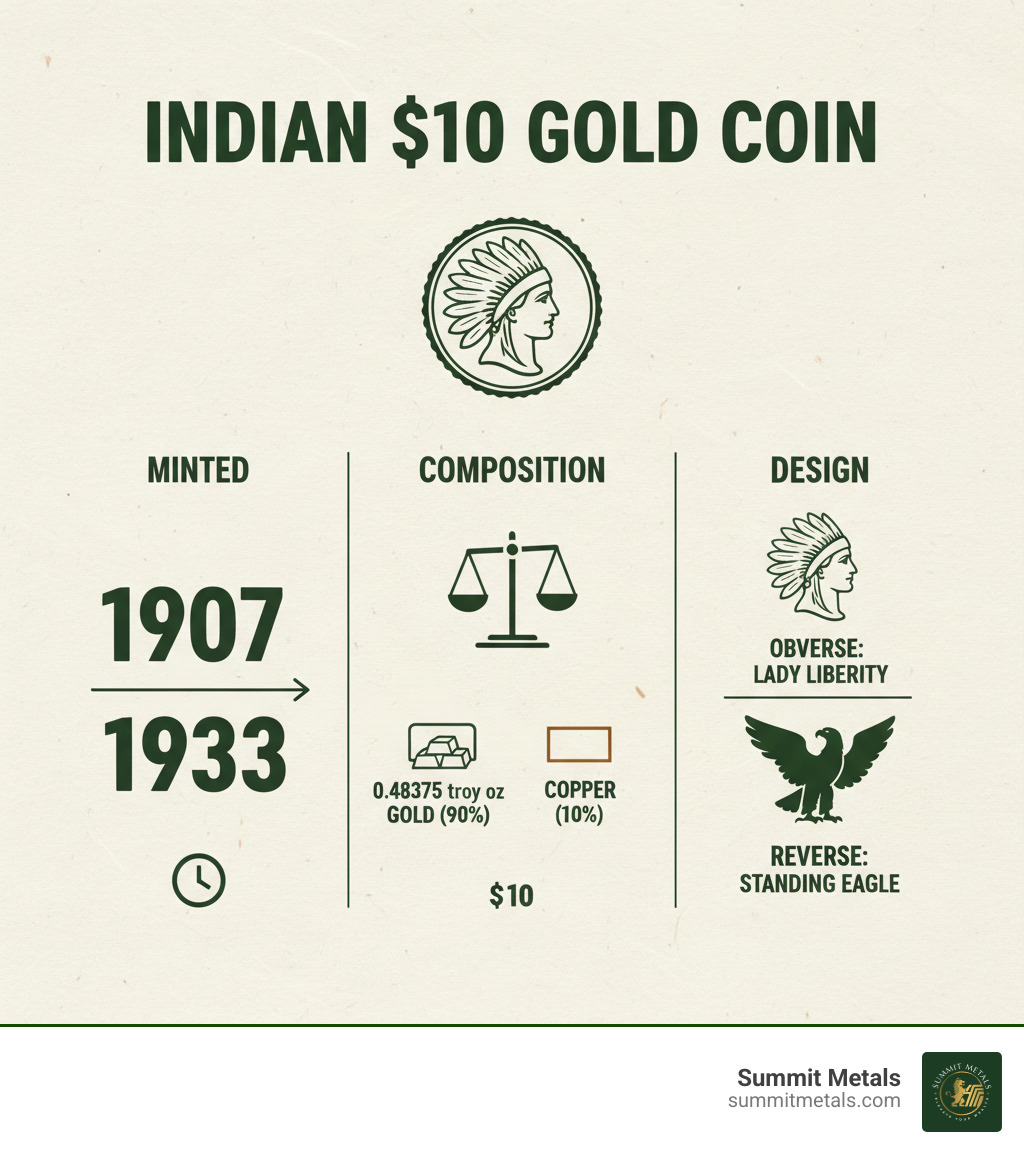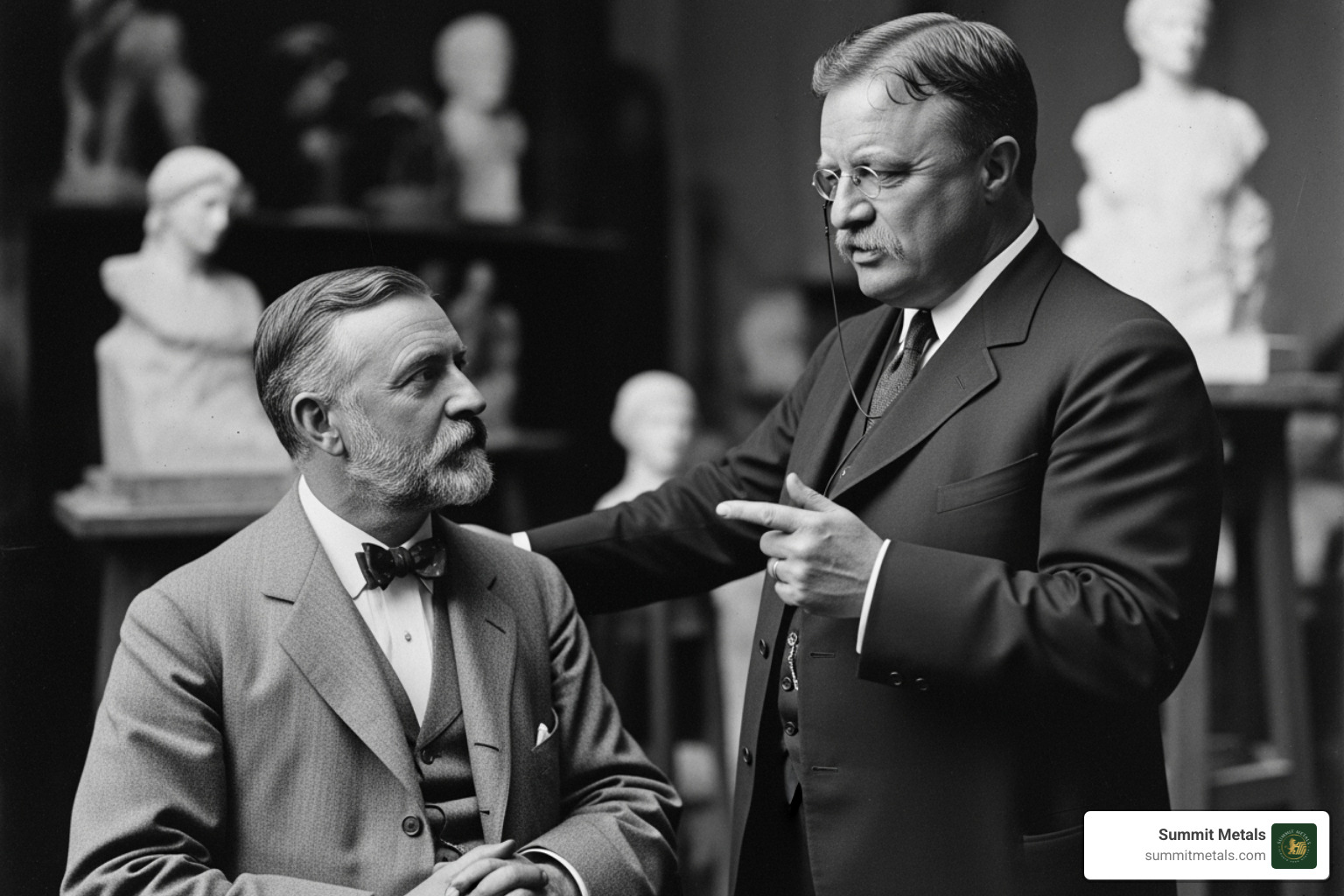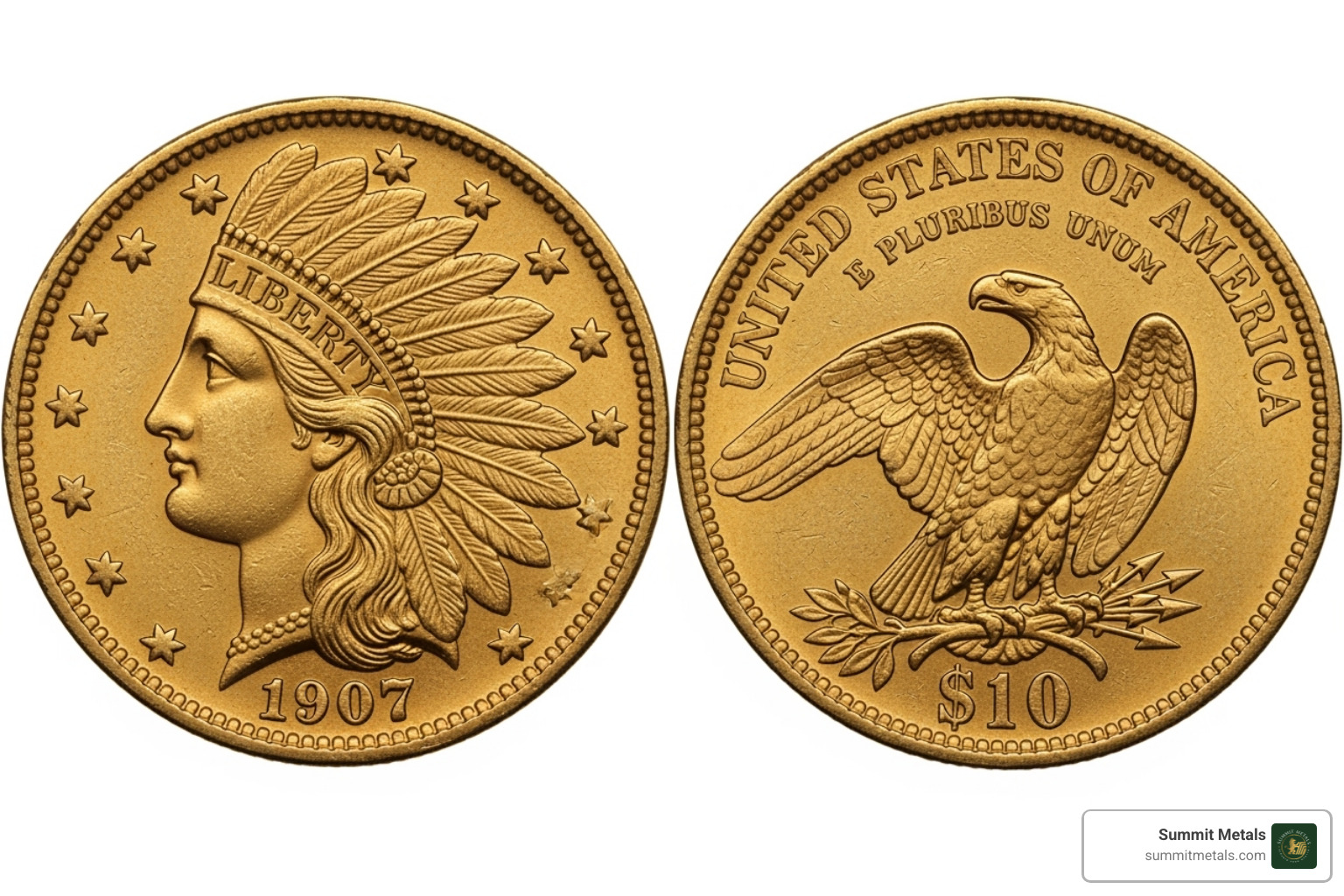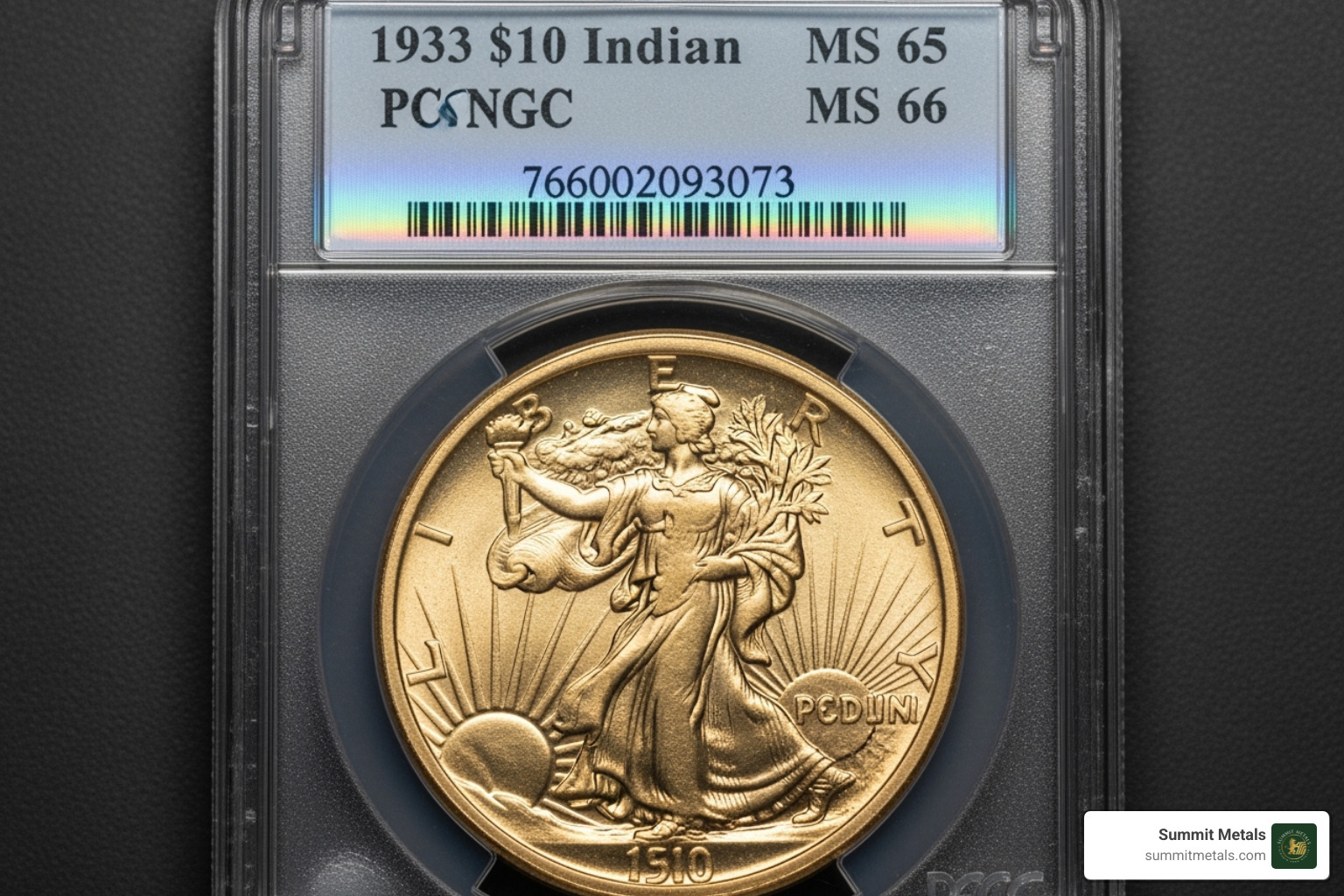Why Indian $10 Gold Coins Stand Apart from Modern Bullion
Indian $10 gold coins represent one of America's most stunning numismatic achievements, combining artistic beauty with precious metal value in ways that modern bullion simply cannot match.
Quick Facts About Indian $10 Gold Coins:
- Years Minted: 1907-1933
- Gold Content: 0.48375 troy ounces of pure gold
- Composition: 90% gold, 10% copper
- Face Value: $10 (legal tender protection)
- Design: Lady Liberty with Native American headdress / Standing eagle
- Key Dates: 1911-D, 1920-S, 1933 (extremely rare)
- Current Value: $1,000+ depending on condition and rarity
These Pre-1933 gold coins offer something no gold bar can provide: dual value streams. Beyond their substantial gold content of nearly half an ounce, they carry numismatic premiums that have grown consistently over decades. The 1933 issue alone has sold for over $700,000 at auction.
Unlike modern bullion, Indian $10 gold coins survived President Franklin Roosevelt's 1933 gold recall largely because many were already in private hands or stored overseas. This historical scarcity, combined with their face value protection against fraud, makes them uniquely appealing to both collectors and investors seeking portfolio diversification.
Why Choose Gold Coins Over Gold Bars?
| Feature | Indian $10 Gold Coin | Gold Bar |
|---|---|---|
| Numismatic Value | ✓ Yes - appreciates over time | ✗ No - only bullion value |
| Face Value Protection | ✓ $10 legal tender | ✗ No legal tender status |
| Historical Significance | ✓ Pre-1933 rarity | ✗ Modern production |
| Fraud Protection | ✓ Difficult to counterfeit | ✗ Easier to fake |
I'm Eric Roach, and during my decade on Wall Street, I've guided clients through complex hedging strategies that often included Indian $10 gold coins as portfolio stabilizers. These historical treasures offer the same institutional-grade risk management benefits I once structured for Fortune 500 companies, but in a form accessible to individual investors.

The Birth of an Icon: Design and Historical Significance
The Indian $10 gold coin emerged from one of the most ambitious artistic collaborations in American history. When President Theodore Roosevelt decided to transform U.S. coinage from mundane to magnificent, he sparked a creative revolution that would forever change how we view American currency.
A Vision for American Coinage
Roosevelt had a problem with American coins – they were boring. Standing next to the beautiful ancient Greek and Roman coins in his collection, U.S. currency looked downright embarrassing. The president dreamed of a "Renaissance of American Coinage" that would showcase America's growing cultural sophistication to the world.
Enter Augustus Saint-Gaudens, the era's most celebrated sculptor. Roosevelt personally commissioned him to redesign American gold coins, marking the first time a major artist was brought in to reimagine U.S. currency. Saint-Gaudens had already created the stunning $20 Double Eagle, and despite battling cancer, he threw himself into perfecting the Indian $10 gold design.

The collaboration wasn't without its challenges. Saint-Gaudens' breathtaking high-relief designs proved nearly impossible for the U.S. Mint to produce efficiently. Chief Engraver Charles Barber found himself caught between artistic vision and manufacturing reality, often clashing with the sculptor over practical modifications needed for mass production.
The Controversial and Celebrated Design
Saint-Gaudens created something America had never seen before: Lady Liberty wearing a Native American war headdress. This bold departure from classical European imagery was meant to represent America's unique identity and democratic spirit.
Not everyone loved it. Numismatic historians had strong opinions about the design. Walter Breen called the headdress "absurd," while art historian Cornelius Vermeule suggested the coin "missed being a great coin because Roosevelt interfered." Critics like Jeff Garrett and Ron Guth pointed out that Native American women wouldn't typically wear male warriors' headdresses, calling the concept "a trifle fantastic."
Despite the controversy, the design captured something essentially American. The reverse featured a majestic bald eagle standing on arrows and an olive branch – symbols of both strength and peace that resonated with the nation's growing confidence.
The artistic debate continues today, but there's no arguing with the coin's enduring appeal. The Indian $10 gold coin became an instant icon, representing not just monetary value but America's artistic ambitions. For deeper insights into the artistry that shaped this and other U.S. coins, Numismatic Art in America offers fascinating historical perspective.
Today, collectors and investors prize these coins not just for their gold content, but for their place in American cultural history. Each Indian $10 gold coin tells the story of a president's vision, an artist's genius, and a nation ready to showcase its creativity to the world.
Anatomy of the Indian $10 Gold Coin
Every Indian $10 gold coin tells a story through its carefully crafted details. When you hold one of these magnificent pieces, you're not just holding precious metal – you're holding a masterpiece of American artistry that evolved over nearly three decades of production.

Obverse and Reverse: A Closer Look
The obverse of the Indian $10 gold coin immediately draws your eye to Lady Liberty's striking profile. She faces left, wearing her distinctive Native American war headdress with "LIBERTY" boldly inscribed across the headband. Thirteen stars circle her portrait – each one representing one of the original colonies that founded our nation. You'll find the year of minting positioned just below Liberty's graceful neck.
Turn the coin over, and the reverse presents an equally powerful image. A majestic bald eagle stands proudly atop a bundle of arrows and an olive branch, perfectly balancing America's military strength with its desire for peace. The inscriptions "UNITED STATES OF AMERICA" and "E PLURIBUS UNUM" frame the eagle from above, while "TEN DOLLARS" clearly states the coin's face value below.
This face value isn't just ceremonial – it provides legal protection against counterfeiting that gold bars simply don't have. That's one reason why savvy investors often choose coins over bars when building their precious metals portfolio.
Key Variations of the Indian $10 Gold Coin
The most dramatic change in the Indian $10 gold series came from an unexpected source: public outrage. When Saint-Gaudens and Roosevelt first created their masterpiece, they deliberately left off "IN GOD WE TRUST" to maintain the coin's clean artistic lines. The American public had other ideas.
The 'No Motto' series from 1907 through early 1908 became instant collector favorites once Congress mandated the motto's inclusion. Starting in late 1908, the 'With Motto' series featured "IN GOD WE TRUST" positioned to the left of the eagle, where it remained through the final 1933 issues.
The 1907 issues offer another fascinating variation story. The earliest strikes featured what collectors call a 'Wire Rim' – a thin, sharp edge that looked stunning but proved impractical. These delicate rims damaged easily during handling and shipping. The Mint quickly switched to a more durable 'Rounded Rim' design, making those early Wire Rim pieces incredibly scarce. One sold for $230,000, while a Rounded Rim specimen brought an astounding $2,185,000 at auction.
Even the coin's edge tells America's growth story. The original 46 stars represented the states in 1907, but when Arizona and New Mexico joined the Union in 1912, the edge stars increased to 48 – a detail that helps collectors date their coins.
Specifications and Minting History
The Indian $10 gold coin's specifications reflect both practicality and precious metal value. Each coin contains 0.48375 troy ounces of pure gold in a composition that's 90% gold and 10% copper. That copper content gives the coin its distinctive warm color and added durability – pure gold would be too soft for circulation.
At 16.718 grams total weight with a diameter of 26.92 mm, these coins feel substantial in your hand. The 2.023 mm thickness gives them the perfect heft that reminds you you're holding real money, not paper promises.
Production wasn't continuous throughout the series' 1907-1933 lifespan. The coins were struck regularly through 1916, then sporadically until that final, legendary 1933 issue. Three mint facilities produced these treasures:
Philadelphia coins carry no mint mark, Denver issues show a "D," and San Francisco coins display an "S." Each location has its own rarity stories and collector following. For detailed production numbers that reveal which dates and mint marks are truly scarce, check out the comprehensive Circulation Mintage Figures.
Understanding these variations helps explain why some Indian $10 gold coins sell for modest premiums over gold content, while others command five or six-figure prices. It's this combination of precious metal value and numismatic rarity that makes them such compelling additions to any investment portfolio – especially when you can build your collection gradually through dollar-cost averaging, just like contributing to a 401(k).
From Currency to Collectible: Value and Rarity
The Indian $10 gold coin has traveled an extraordinary journey from everyday currency to one of America's most prized collectibles. What started as legal tender worth ten dollars in 1907 has transformed into numismatic treasures commanding thousands—and sometimes hundreds of thousands—of dollars at auction.
This change wasn't accidental. It's the result of historical forces, government actions, and the simple passage of time that has made these coins increasingly scarce and desirable.
Factors Influencing the Value of an Indian $10 Gold Coin
When you're looking at an Indian $10 gold coin, you're not just holding 0.48375 troy ounces of gold. You're holding a piece of American history whose value depends on several fascinating factors.
Condition is everything in the coin world. Professional grading services like PCGS and NGC examine every detail under magnification, assigning grades that can make the difference between a $1,000 coin and a $10,000 one. A common date Indian $10 gold coin in About Uncirculated (AU) condition might start around $1,073, while the same coin in pristine Uncirculated condition could command $1,382 or more. Prices shown are at the time of this publication.
Rarity drives collectors wild, and certain dates are legendary among numismatists. The 1911-D stands out with only 30,100 pieces ever minted, making it a significant rarity that collectors actively hunt. The 1920-S tells an even more dramatic story—despite 126,500 being minted, most were melted down, leaving survivors extremely scarce.
But nothing compares to the 1933 Indian $10 gold coin. This is the holy grail of the series. While 312,500 were originally minted, virtually the entire mintage was melted following President Roosevelt's Executive Order 6102. Only a handful survived, making them among the most valuable U.S. coins ever produced. One 1933 example graded MS-66 sold for an astounding $718,750 at auction.
Executive Order 6102 changed everything for gold coin collectors. On April 5, 1933, President Franklin D. Roosevelt essentially banned private gold ownership during the Great Depression, requiring citizens to turn in their gold coins for paper money. Millions of Indian $10 gold coins went straight to the melting pot, dramatically reducing survival rates and creating the rarity we see today.
This historical event is why pre-1933 gold carries such strong numismatic premiums beyond just the gold content.

Indian $10 Gold vs. Other Gold Investments
Understanding how Indian $10 gold coins stack up against modern alternatives helps explain why savvy investors often choose historical gold over contemporary bullion.
| Feature | Indian $10 Gold Coin | American Gold Eagle (Modern Bullion) | 1/2 oz Gold Bar |
|---|---|---|---|
| Numismatic Value | ✓ Significant historical premium | ✗ Limited premium over spot | ✗ None - just spot price |
| Face Value Protection | ✓ $10 legal tender status | ✓ $50 legal tender status | ✗ No government backing |
| Gold Content | 0.48375 troy oz | 0.9167 troy oz | 0.5 troy oz |
| Historical Significance | ✓ Pre-1933 rarity, rich backstory | ✗ Modern production | ✗ Modern production |
| Fraud Protection | ✓ Extremely difficult to counterfeit | ✓ Government-backed authenticity | ✗ Easier to fake |
The face value protection deserves special attention. Unlike gold bars, Indian $10 gold coins carry legal tender status backed by the U.S. government. This means even in the unlikely scenario where gold prices collapsed, your coin is still worth its face value. It's a safety net that gold bars simply can't provide.
Numismatic value sets these coins apart from pure bullion plays. While a gold bar tracks spot prices, historical Indian $10 gold coins often appreciate faster due to their collector appeal and fixed supply. You're essentially getting two investments in one—precious metals exposure plus collectible appreciation.
Compared to the larger $20 Saint-Gaudens Double Eagle, the Indian $10 gold offers a more accessible entry point into pre-1933 gold collecting while still delivering substantial gold content. It also outshines its smaller cousin, the $5 Indian Gold Coin, with nearly double the gold content and often stronger numismatic premiums.
Investing in Pre-1933 Gold
Pre-1933 gold coins like the Indian $10 gold serve as powerful tangible assets in an increasingly digital world. They provide excellent hedging against inflation while offering portfolio diversification beyond traditional stocks and bonds.
The beauty of these coins lies in their dual nature—they're both precious metals investments and historical collectibles. This combination often leads to appreciation that exceeds spot gold prices, especially during times of economic uncertainty.
At Summit Metals, we believe in making gold investing accessible and systematic. Our dollar-cost averaging strategy through the Autoinvest program works just like investing in a 401k. You can set up automatic monthly purchases, buying more when prices are low and less when they're high. This disciplined approach smooths out market fluctuations and builds wealth steadily over time.
Whether you're drawn to the artistic beauty, the historical significance, or the investment potential, Indian $10 gold coins offer a compelling way to own a piece of American numismatic history. You can easily set up your gold savings plan and start building your precious metals portfolio today.
Frequently Asked Questions about the Indian $10 Gold Coin
At Summit Metals, we love talking about these incredible pieces of American history. The Indian $10 gold coin sparks curiosity wherever it goes, and we're here to answer the questions that matter most to our clients.
How much is a $10 Indian gold coin worth?
Here's where things get exciting – an Indian $10 gold coin is worth so much more than its face value suggests! At its foundation, you've got the base value from its gold content of 0.48375 troy ounces of pure gold. But that's just the starting point.
The real magic happens with the collector premium. These coins carry significant numismatic value that often far exceeds their gold content alone. A circulated, common date coin might start around $1,073, while an Uncirculated condition example could begin at approximately $1,382. Prices shown are at the time of this publication.
But here's where it gets really interesting – rarity matters tremendously. Those special date and mint mark combinations like the 1911-D, 1920-S, or the legendary 1933 can push values into the thousands or even tens of thousands of dollars. The market value range truly spans from over $1,000 for common dates to astronomical figures for the rarest specimens.
Professional grading from PCGS or NGC is your best friend here. A single grade point can mean hundreds or thousands of dollars in value difference.
How can I tell if my $10 Indian gold coin is real?
Nobody wants to find their treasure isn't genuine, so let's talk authentication. The good news? Genuine Indian $10 gold coins have very specific characteristics that are hard to fake perfectly.
Start by checking the specifications – your coin should weigh exactly 16.718 grams and measure 26.92 mm in diameter. These aren't suggestions; they're precise measurements that counterfeiters often get wrong.
Next, examine those design details with a magnifying glass. The intricate feathers in Liberty's headdress, the eagle's features, and the sharpness of the lettering should all be crisp and clear. Counterfeits typically show blurry or mushy details where the genuine article is sharp.
Don't forget about those edge stars – 46 stars for earlier years, 48 for 1912 and later. Fakers sometimes miss this detail entirely.
For peace of mind, we always recommend consulting reputable dealers like Summit Metals or submitting your coin to third-party grading services like PCGS or NGC. These experts have specialized equipment and decades of experience spotting even the most sophisticated fakes.
Is the Indian $10 gold coin a good investment?
This is where we get really enthusiastic! The Indian $10 gold coin offers something truly special in the investment world – dual value streams that work independently and together.
First, there's the bullion component. With nearly half an ounce of gold, these coins provide an excellent hedge against inflation and economic uncertainty. Gold has been a store of value for thousands of years, and that's not changing anytime soon.
But here's the kicker – the numismatic value often appreciates faster than gold itself. The historical scarcity created by the 1933 gold recall means these coins become rarer over time, not more common. They represent a tangible piece of U.S. history that appeals to both collectors and smart investors.
The long-term store of value aspect is particularly compelling. While gold prices fluctuate, the historical significance and artistic beauty of these coins create a floor value that pure bullion can't match. Their appeal to both collectors and investors means you have multiple markets when it's time to sell.
For building wealth systematically, consider our Autoinvest program. Just like contributing to a 401k, you can dollar-cost average into precious metals, buying more when prices are low and less when they're high. It's a disciplined approach that takes emotion out of investing.
Want to explore how these compare to modern options? Learn more about modern gold coin investments and see how historical pieces like the Indian $10 gold coin fit into a well-rounded precious metals portfolio.
The Enduring Legacy of a Coinage Masterpiece
More than a century after its creation, the Indian $10 gold coin remains one of America's most beloved numismatic treasures. What began as President Theodore Roosevelt's ambitious dream to lift American coinage has become a lasting symbol of artistic achievement and historical significance.
These remarkable coins tell a story that goes far beyond their precious metal content. They represent a pivotal moment when art and commerce intersected, when a president dared to challenge conventional design, and when master sculptor Augustus Saint-Gaudens created something truly extraordinary despite facing his own mortality.
The Indian $10 gold coin's survival through the tumultuous events of 1933 adds another layer to its mystique. While millions of gold coins were melted down during the Great Depression's gold recall, these survivors became inadvertent time capsules, preserving not just their gold content but the artistic vision of their creators.
For today's collectors, owning an Indian $10 gold coin means holding a tangible piece of U.S. history. Each coin carries the weight of Roosevelt's Renaissance vision, the controversy surrounding Liberty's Native American headdress, and the craftsmanship challenges that pushed the U.S. Mint to new heights of artistic production.
Investors find equal appeal in these coins' dual value proposition. Unlike modern bullion that trades purely on gold content, the Indian $10 gold coin offers both precious metal security and numismatic appreciation potential. Their pre-1933 scarcity means they often outperform the spot price of gold, making them compelling additions to diversified portfolios.
At Summit Metals, we understand that these coins represent more than just an investment—they're pieces of American heritage that continue to inspire new generations of collectors and investors. Our transparent pricing and authentication process ensures you're getting genuine pieces of this remarkable legacy.
Whether you're drawn to their artistic beauty, historical significance, or investment potential, Indian $10 gold coins offer something truly special in today's precious metals market. They remind us that currency can be art, that controversy can create beauty, and that the best investments often come with the richest stories.
Ready to own a piece of this extraordinary legacy? Start or grow your precious metals collection today and find why the Indian $10 gold coin continues to captivate collectors and investors more than 90 years after its final minting.



